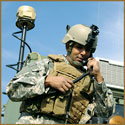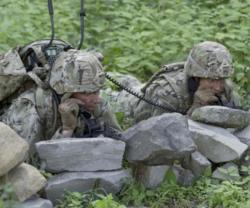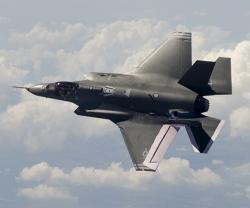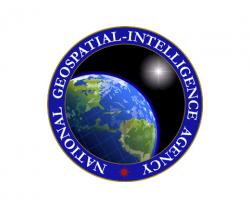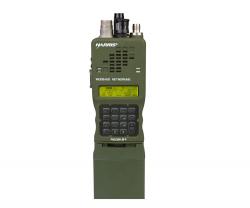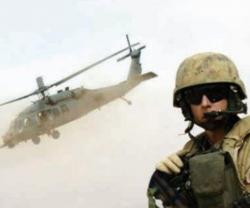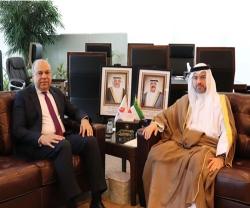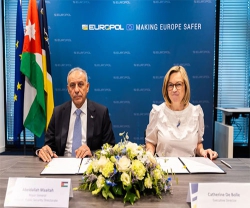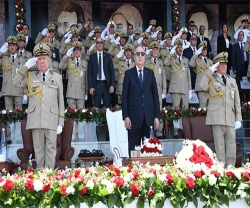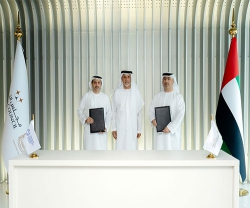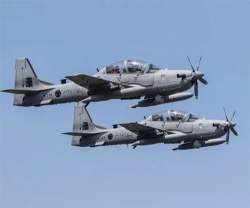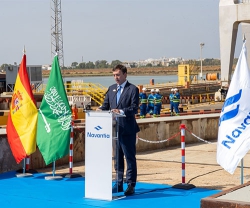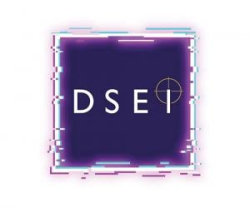Harris Highband Networking Radio
30.06.2011 Products
The Harris Highband Networking Radio(tm) created the mobile, wideband communications network infrastructure for various mission scenarios at the Empire Challenge 2011, which showcases emerging intelligence, surveillance and reconnaissance (ISR) technologies that support warfighters at the tactical edge. The annual multinational interoperability demonstration, held at Fort Huachuca, Arizona, was run by the U.S. Joint Forces Command.
The enhanced Harris Highband Networking Radio (HNRe2) combines directive-beam technology with mobile, ad hoc mesh networking capabilities and a reduced size, weight and power antenna optimized for airborne platforms.
During the exercise, the HNRe2 enabled critical communications - including transmission of ISR data - from ground and airborne assets to the tactical edge and to individual participants using smartphones.
Five HNRe2 terrestrial nodes were used to create the self-forming, self-healing mesh ground network. One was deployed at each of two R3G biometric network cells; one at a ground site that served as the fiber entry point to the Intelligence Systems Integration Laboratory at Ft. Huachuca; another at the top of a hill as a backup relay point; and the fifth, a mobile node, was installed on the roof of an SUV.
The airborne network consisted of an HNRe2 airborne payload package deployed on the Northrop Grumman Firebird, an intelligence-gathering aircraft that can be flown by a pilot or operated as an unmanned aerial vehicle (UAV). When airborne, the HNRe2 network automatically connected the two R3G cells on the ground, demonstrating the HNRe2's capability to act as a relay link and simulating separation of up to 150 km between the R3G sites.
In the airborne application, the HNRe2 was used to pull sensor data and streaming video from the aircraft to the mobile node and then distribute the data to a wireless access point, from which it was disseminated to dismount smartphone devices. In addition, the HNRe2 network was used to remotely control the Firebird aircraft and its ISR payload devices. Weighing just 62 pounds, the HNRe2 payload was installed or changed from another payload on the Firebird airframe in just 30 minutes. HNRe2 network burst rate capacity between nodes can vary from 6 Mbps to 54 Mbps.
"The HNRe2 terrestrial and airborne components formed a single, robust, high-bandwidth network that was able to meet all the demands of the mission," said Sheldon Fox, Group President, Harris Government Communications Systems. "Harris was specifically asked to provide and demonstrate this capability during EC 2011 as a result of earlier integration efforts with the R3G system. Participating in this event is key to our understanding of how the HNRe2 can best meet the needs of the warfighter, as well as the Army's vision for how it can apply this technology for maximum benefit in a variety of mission scenarios."
The enhanced Harris Highband Networking Radio (HNRe2) combines directive-beam technology with mobile, ad hoc mesh networking capabilities and a reduced size, weight and power antenna optimized for airborne platforms.
During the exercise, the HNRe2 enabled critical communications - including transmission of ISR data - from ground and airborne assets to the tactical edge and to individual participants using smartphones.
Five HNRe2 terrestrial nodes were used to create the self-forming, self-healing mesh ground network. One was deployed at each of two R3G biometric network cells; one at a ground site that served as the fiber entry point to the Intelligence Systems Integration Laboratory at Ft. Huachuca; another at the top of a hill as a backup relay point; and the fifth, a mobile node, was installed on the roof of an SUV.
The airborne network consisted of an HNRe2 airborne payload package deployed on the Northrop Grumman Firebird, an intelligence-gathering aircraft that can be flown by a pilot or operated as an unmanned aerial vehicle (UAV). When airborne, the HNRe2 network automatically connected the two R3G cells on the ground, demonstrating the HNRe2's capability to act as a relay link and simulating separation of up to 150 km between the R3G sites.
In the airborne application, the HNRe2 was used to pull sensor data and streaming video from the aircraft to the mobile node and then distribute the data to a wireless access point, from which it was disseminated to dismount smartphone devices. In addition, the HNRe2 network was used to remotely control the Firebird aircraft and its ISR payload devices. Weighing just 62 pounds, the HNRe2 payload was installed or changed from another payload on the Firebird airframe in just 30 minutes. HNRe2 network burst rate capacity between nodes can vary from 6 Mbps to 54 Mbps.
"The HNRe2 terrestrial and airborne components formed a single, robust, high-bandwidth network that was able to meet all the demands of the mission," said Sheldon Fox, Group President, Harris Government Communications Systems. "Harris was specifically asked to provide and demonstrate this capability during EC 2011 as a result of earlier integration efforts with the R3G system. Participating in this event is key to our understanding of how the HNRe2 can best meet the needs of the warfighter, as well as the Army's vision for how it can apply this technology for maximum benefit in a variety of mission scenarios."
Previous PostAlenia Aermacchi Selects Barco for M-346 Simulator
Latest news
Latest events
IDEF 2025 Turkey - International Defence Industry Fair
22 - 27 Jul 2025Istanbul Expo Center - TurkeyDSEI 2025
09 - 12 Sep 2025Excel, London - United KingdomIntersec Saudi Arabia
29 Sep - 01 Oct 2025Riyadh International Exhibition & Convention Centre - Saudi ArabiaDubai International Air Chiefs’ Conference (DIACC 2025)
16 Nov 2025Atlantis, The Palm Dubai - United Arab Emirates

